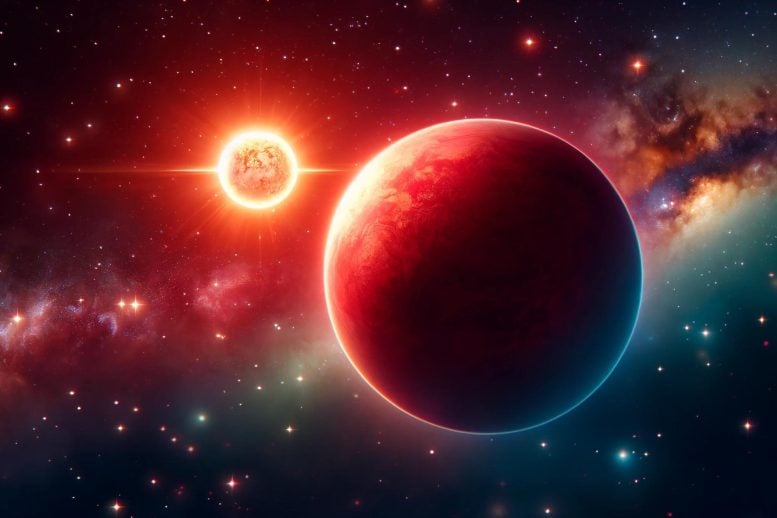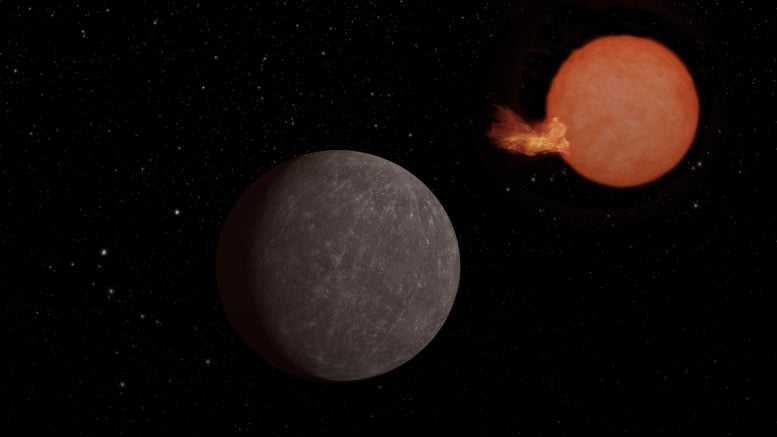
An international team has discovered an Earth-sized planet orbiting a long-lived red dwarf, providing a unique glimpse into potentially habitable worlds. Credit: SciTechDaily.com
Researchers using global robotic telescopes have discovered an Earth-sized planet, SPECULOOS-3 b, orbiting an ultra-cold red dwarf in space.
” data-gt-translate-attributes=”({“attribute”:”data-cmtooltip”, “format”:”html”})” tabindex=”0″ role=”link”>Milky Way. This planet, tidally locked and likely lacking an atmosphere due to intense radiation, offers new insights into long-lived red dwarfs, which are expected to be among the last burning stars in the universe.
Our galaxy is a treasure trove of red stars. In fact, more than 70% of stars in the Milky Way are M dwarfs, also called red dwarfs. These stars are cool and dim compared to our Sun, but they often shed high-energy radiation onto orbiting exoplanets, especially early in their lives. And these “lives” last a long time. Stars like our Sun burn for about 10 billion years before turning into hungry red giants devouring any planets too close. M dwarfs continue to burn for 100 billion years or more, perhaps providing a foothold for life and an even longer window for life to develop.
An international team using robotic telescopes around the world recently spotted an Earth-sized planet orbiting an ultra-cool red dwarf, the darkest and longest-lived star. When the universe becomes cold and dark, it will be the last stars that burn.
Discovery
THE
” data-gt-translate-attributes=”({“attribute”:”data-cmtooltip”, “format”:”html”})” tabindex=”0″ role=”link”>exoplanet SPECULOOS-3 b is about 55 light years from Earth (very close if we consider the cosmic scale!) and about the same size. A year there, an orbit around the star takes about 17 hours. The days and nights, however, may never end: the planet is thought to be tidally locked, so the same side, known as the day side, always faces the star, like the Moon faces the Earth. The night would be locked in endless darkness.

Artist’s impression of the exoplanet SPECULOOS-3 b orbiting its red dwarf star. The planet is as large as Earth, while its star is slightly larger than Jupiter – but much more massive. Credit: Lionel Garcia
Exploring the Ultra-Cool Dwarves
In our corner of the galaxy, ultra-cool dwarf stars are omnipresent. They are so small that their planetary population is largely unexplored. The SPECULOOS (Search for Planets EClipsing ULtra-cOOl Stars) project, led by Michael Gillon of the University of Liège, Belgium, was designed to change this. Ultra-cool dwarf stars are scattered across the sky, so you need to observe them one by one, over weeks, to have a good chance of detecting transiting planets. For this you need a dedicated network of professional telescopes. This is the concept of SPECULOOS.
“We designed SPECULOOS specifically to explore nearby ultra-cool dwarf stars in search of rocky planets,” Gillon said. ”With the SPECULOOS prototype and the crucial help of
” data-gt-translate-attributes=”({“attribute”:”data-cmtooltip”, “format”:”html”})” tabindex=”0″ role=”link”>NASA With the Spitzer space telescope, we discovered the famous TRAPPIST-1 system. It was a great start!
Gillon is the lead author of the article announcing the discovery of the planet, published on May 15, 2024 in Natural astronomy. The project is a truly international undertaking, in partnership with the universities of Cambridge, Birmingham, Bern, the Massachusetts Institute of Technology and ETH Zürich.
The SPECULOOS-3 star is thousands of degrees cooler than our Sun with an average temperature of about 4,760 F (2,627 C), but it hits its planet with radiation, meaning there is no probably no atmosphere.
Seeing the star, let alone the planet, is a feat in itself. “Although this particular red dwarf is more than a thousand times dimmer than the Sun, its planet orbits much closer than Earth, warming the planetary surface,” said co-author Catherine Clark, a postdoctoral researcher at the Jet Propulsion Laboratory in The NASA. in Southern California.
Fun facts
- Although the planet is as large as Earth, its star is just a bit larger than Earth.
JupiterJupiter is the largest planet in the solar system and the fifth planet from the Sun. It is a gas giant whose mass is greater than all the other planets combined. Its name comes from the Roman god Jupiter.
” data-gt-translate-attributes=”({“attribute”:”data-cmtooltip”, “format”:”html”})” tabindex=”0″ role=”link”>Jupiter – but much more massive.
- The planet receives nearly 16 times more energy per second than Earth receives from the Sun.
- Have you detected the connection of cookies? The SPECULOOS planet research program shares its name with spicy shortbread. Both are from Belgium. Soft!
The next steps
SPECULOOS-3 b is an excellent candidate for follow-up observations by the James Webb Space Telescope. Not only could we learn more about the potential of an atmosphere and surface mineralogy, but it could also help us understand the stellar neighborhood and our place in it.
“We are making great progress in our study of planets orbiting other stars. We have now reached the stage where we can detect and study Earth-sized exoplanets in detail. The next step will be to determine whether “One of them is habitable, even inhabited,” said Steve B. Howell, one of the planet’s discoverers at NASA’s Ames Research Center in Silicon Valley.
To find out more about this discovery:
Reference: “Detection of an Earth-sized exoplanet orbiting the ultra-cold dwarf star SPECULOOS-3” by Michael Gillon, Peter P. Pedersen, Benjamin V. Rackham, Georgina Dransfield, Elsa Ducrot, Khalid Barkaoui, Artem Y. Burdanov, Urs Schroffenegger, Yilen Gomez Maque Chew, Susan M. Lederer, King Alonso, Adam J. Burgasser, Steve B. Howell, Norio Narita, Julien de Wit, Brice-Olivier Demory, Didier Queloz, Amaury HMJ Triaud, Laetitia Delrez, Emmanuel Jehin, Matthew J. Hooton, Lionel J. Garcia, Claudia Jano Munoz, Catriona A. Murray, Francisco J. Pozuelos, Daniel Sebastian, Mathilde Timmermans, Samantha J. Thompson, Sebastian Zuniga-Fernandez, Jesus Olive , Christian Aganze, Pedro J. Love, Thomas Baycroft, Zouhair Benkhaldoun, David Berardo, Emeline Bolmont, Catherine A. Clark, Yasmin T. Davis, Fatemeh Davoudi, Zoë L. de Beers, Jerome P. de Leon, Masahiro Ikoma, Kai Ikuta, Keisuke Isogai, Izuru Fukuda, Akihiko Fukui, Roman Gerasimov, Mourad Ghachoui, Maximilian N. Günther, Samantha Hasler, Yuya Hayashi, Kevin Heng, Renyu Hu, Taiki Kagetani, Yugo Kawai, Kiyoe Kawauchi, Daniel Kitzmann, Daniel DB Koll, Monika Lendl, John H. Livingston, Xintong Lyu, Erik A. Meier Valdés, Mayuko Mori, James J. McCormac, Philip Murgas, Prajwal Niraula, Enric Palle, Ilse Plauchu-Frayn, Rafael Rebolo, Laurence Sabin, Yannick Schackey, Nicole Schanche , Franck Selsis, Alfredo Sota, Manu Stalport, Matthew R. Standing, Keivan G. Stassun, Motohide Tamura, Yuka Terada, Christopher A. Theissen, Martin Turbet, Valerie Van Grootel, Roberto Varas, Noriharu Watanabe and Francis Zong Lang, May 15 Natural astronomy.
DOI: 10.1038/s41550-024-02271-2